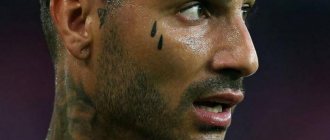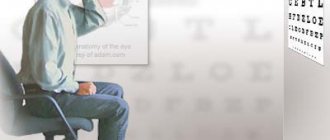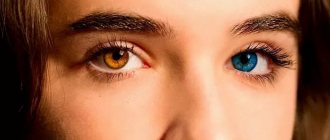Human vision
Vision in human life is a window to the world. Everyone knows that we acquire 90% of information through our eyes, so the concept of 100% visual acuity is very significant for a full life. The organ of vision in the human body does not take up much space, but is a unique, very interesting, complex formation that has not yet been fully explored.
What is the structure of our eye? Not everyone knows that we see not with our eyes, but with our brain, where the final image is synthesized.
The visual analyzer is formed from four parts:
- The peripheral part, which includes: - the eyeball itself; - upper and lower eyelids, eye socket; - appendages of the eye (lacrimal gland, conjunctiva); - extraocular muscles.
- Pathways in the brain: optic nerve, chiasm, tract.
- Subcortical centers.
- Higher visual centers in the occipital lobes of the cerebral cortex.
The following are recognized in the eyeball:
- cornea;
- sclera;
- iris;
- lens;
- ciliary body;
- vitreous body;
- retina;
- choroid.
The sclera is an opaque part of a dense fibrous membrane. Because of its color, it is also called the protein shell, although it has nothing in common with egg whites.
The cornea is a transparent, colorless part of the fibrous membrane. The main responsibility is focusing the light, bringing it to the retina.
The anterior chamber is the area between the cornea and the iris, filled with intraocular fluid.
The iris, which determines the color of the eyes, is located behind the cornea, in front of the lens, divides the eyeball into two sections: anterior and posterior, and controls the amount of light that reaches the retina.
The pupil is a round hole located in the middle of the iris that regulates the amount of light entering
The lens is a colorless formation that performs only one task - focusing rays on the retina (accommodation). Over the years, the lens of the eye thickens and a person's vision deteriorates, which is why most people need reading glasses.
The ciliary or ciliary body is located behind the lens. A watery fluid is produced inside it. There are also muscles that allow the eye to focus on objects at different distances.
The vitreous body is a transparent gel-like mass with a volume of 4.5 ml that fills the cavity between the lens and the retina.
The retina is made up of nerve cells. It lines the back surface of the eye. The retina, under the influence of light, creates impulses that are transmitted through the optic nerve to the brain. Therefore, we perceive the world not with our eyes, as many people think, but with our brain.
Approximately in the center of the retina there is a small but very sensitive area called the macula or macula. The fovea or fovea is the very center of the macula, where the concentration of visual cells is maximum. The macula is responsible for the clarity of central vision. It is important to know that the main criterion for visual function is central visual acuity. If light rays are focused in front of or behind the macula, a condition called refractive error occurs: farsightedness or nearsightedness, respectively.
The choroid is located between the sclera and the retina. Its vessels nourish the outer layer of the retina.
The extrinsic eye muscles are the 6 muscles that move the eye in different directions. There are rectus muscles: superior, inferior, lateral (to the temple), medial (to the nose) and obliques: superior and inferior.
The science of vision is called ophthalmology. She studies the anatomy, physiology of the eyeball, diagnosis and prevention of eye diseases. This is where the name of the doctor who treats eye problems comes from - ophthalmologist. And the synonymous word - ophthalmologist - is now used less often. There is another direction - optometry. Specialists in this field diagnose and treat human vision, correct various refractive errors using glasses and contact lenses - myopia, farsightedness, astigmatism, strabismus... These teachings were created in ancient times and are actively developing now.
The role of vision in human life and the consequences of its impairment
The role of vision in a person’s reflection of the surrounding world is exceptionally great. In the process of phylogenesis, man was formed as an “optical being” (S.L. Rubinshtein), which is due, on the one hand, to the importance of light for the existence of life on Earth, and on the other, to a number of factors, starting with upright walking, which led to the separation of man from animal world.
Mental activity is essentially a reflective activity, and in the course of anthropogenesis, a complex system of analyzers has been formed in humans, ensuring the flow of information necessary for normal life activity from the outside world. In this system, the visual, auditory and tactile-kinesthetic systems come to the fore, underlying the so-called gnostic, that is, having the greatest cognitive value, sensations and perceptions. It should be borne in mind that in this complex of analyzers the leading role in the process of sensory reflection belongs to vision.
In order to understand the extent to which the sphere of sensory notation suffers, and, naturally, subsequent levels of reflective activity as a result of complete or partial disruption of the functions of the visual analyzer, let us consider what the functions of vision are in human reflective activity
The human eye, adapted to the reception of light energy, has a remarkable ability to navigate the world around it, identifying individual objects and spatial relationships between them by their illumination. At the same time (p. 6) the visual analyzer has an unusually high sensitivity. Visual receptors are the most advanced light detectors. For the sensation of light to occur, only a few quanta are needed, and if it were possible to create ideal conditions for perception (absolutely transparent air, etc.), then a person could see a burning candle at a distance of about 27,000 m.
Visual sensations and perceptions provide a person with the largest amount of finely differentiated data of the widest range. Suffice it to say that the number of visual fixations in just one day in a person reaches approximately 100,000, although, of course, not all of them become facts of consciousness and are informational, which is explained by the selectivity of perception.
It is also important that the field of visual perception is practically unlimited.
THEM. Sechenov wrote that the eye distinguishes eight categories of features: color, shape, size, distance, direction, corporeality, rest and movement, which allows vision to adequately reflect actual spatial relationships.
Of course, vision is not the only structural unit of sensory cognition that correctly reflects the world around us, however, wrote S.L. Rubinstein, “vision gives us the most perfect, genuine perception of objects. Visual sensations are most differentiated from efficiency; the moment of sensory contemplation is especially strong in them. Visual perceptions are the most “objectified”, objectified perceptions of a person. That is why they are very important for cognition and for practical action.” (Rubinstein S.L. Fundamentals of general psychology. - M., 1989. P. 227.)
Visual sensations and perceptions are of great importance not only for cognition and practical activity, but are also an inexhaustible source of aesthetic experiences. This is especially true for color vision, which promotes better perception of objects. “People,” wrote Goethe, “in general, are very happy about flowers. The eye feels the need to see color. Let us remember the pleasant revival that we experience when, on a cloudy day, the rays of the sun fall on part of the visible (p. 7) landscape and the colors of the illuminated objects become clearly visible to us.”
Here we should also cancel the important role that vision plays in almost all types of activity. With the help of vision, a person monitors the correctness of the actions performed. For example, when developing the skill of writing, a child with normal vision controls his hand movements visually. In this case, the blind person monitors the correctness of the movements with the help of his hand. This circumstance significantly complicates and impedes the development of writing skills.
It is quite obvious that partial, and even more so complete loss of vision entails the most serious and often irreparable losses in the area of sensory reflection. The effect of a reduction in sensory experience on mental life has been noted by many psychologists. S.L. Rubinstein wrote, but in this regard the following: “Not from any description, no matter how vivid it may be, does a blind person recognize the colorfulness of the world, and a deaf person - the musicality of its sound as if he had directly accepted them; no psychological treatise can replace the one who himself has not experienced love, the passion of struggle and the joy of creativity, what he would experience if he himself experienced them.” (Rubinstein S.L. Fundamentals of general psychology. - M., 1989. P. 5.)
The impossibility or significant limitations of receiving visual stimuli entails deviations in mental development, which, in modern psychological literature, are designated as deprivation damage. “Mental deprivation is a mental state that arises as a result of such life situations where the subject is not given the opportunity to satisfy some of his basic (life) mental needs in sufficient measure and for a sufficiently long time.” (Langmeyer J., Matejcek Z. Psychological deprivation in childhood. - Prague, 1984, p. 19) The authors of the above definition indicate that such needs are perceptual need, that is, the need for a certain quantity and quality of external stimuli (stimuli), the need in social connections with parents, peers, etc., ensuring the integration of the individual, and, finally, the need for (p. 8) conditions for learning and subsequent self-realization, mastering certain social roles.
Based on the foregoing, it should be considered that visual impairment entails not only sensory (visual) deprivation, but also emotional (affective) and social deprivation. It should also be borne in mind that with congenital or early acquired blindness, children are deprived of not only visual stimuli - their stimulation of other modalities is sharply reduced due to the insufficient development of intact analyzers, limited mobility, and poverty of social connections and relationships. All this entails noticeable and very diverse changes in behavior and somatic state; quite often, with blindness and low vision, neuropsychic disorders are observed.
Pathology of visual perception (decreased visual acuity, narrowing of the field of view, disturbances of color and color discrimination) negatively affects the mental development of the blind and visually impaired.
Quantitative changes are observed mainly in the sphere of sensory cognition: in the blind and visually impaired, visual sensations and perceptions are significantly reduced or completely lost, and the number of ideas that limit the ability to form imaginative images decreases accordingly.
As for the qualitative features of the psyche of persons with visual impairments, they manifest themselves, albeit to varying degrees, in almost all areas of mental activity: the system of interaction between analyzers changes, certain specific features arise in the process of forming images, concepts, speech, the relationship between figurative and conceptual is disrupted in mental activity, individual changes are observed in the emotional-volitional sphere and some personality traits, orienting activity acquires a specific character, etc. All these features will be discussed in detail in subsequent chapters.
Complete or partial impairment of visual functions also affects physical development, which is due to the complexity of spatial orientation and the resulting restriction of the blind in freedom of movement. A sedentary lifestyle, in turn, causes muscle weakness, skeletal deformation, hypofunction of internal organs, etc. (p.9)
In general, in the blind and visually impaired (with spontaneous, uncorrected development), somatic weakness is observed (functional failure of the cardiovascular system, somatovegetative deviations), posture and gait are disturbed, changes in the motor are observed - obsessive movements appear (for example, pressure on the eyeballs, swaying head, monster). Hypokinesia, that is, decreased motor activity, is widespread. Disorders of the nervous system, especially the autonomic one, are often observed. In some cases, due to a sharp reduction in sensory afferentation, psychopathological personality changes are possible.
The changes in the mental and physical development of the blind and visually impaired, listed even in the most general terms, convincingly show the need for a special study of their psyche in order to more fully and quickly overcome and prevent the consequences of visual defects.
Eye examination.
At an appointment at the clinic, the doctor can diagnose the eyes using an external examination, special instruments and functional research methods.
External inspection takes place in daylight or artificial light. The condition of the eyelids, orbit, and visible part of the eyeball is assessed. Sometimes palpation, such as palpation of intraocular pressure, may be used.
Instrumental research methods make it possible to find out much more accurately what is wrong with the eyes. Most of them are carried out in a dark room. Direct and indirect ophthalmoscopy, examination with a slit lamp (biomicroscopy), a goniolens, and various devices for measuring intraocular pressure are used.
Thus, thanks to biomicroscopy, you can see the structures of the front part of the eye at very high magnification, as if under a microscope. This allows you to accurately identify conjunctivitis, corneal diseases, and clouding of the lens (cataract).
Ophthalmoscopy helps to obtain a picture of the posterior part of the eye. It is performed using reverse or direct ophthalmoscopy. A mirror ophthalmoscope is used to use the first, ancient method. Here the doctor receives an inverted image, magnified 4 to 6 times. It is better to use a modern electric manual direct ophthalmoscope. The resulting image of the eye when using this device, magnified 14 to 18 times, is direct and corresponds to reality. During the examination, the condition of the optic nerve head, macula, retinal vessels, and peripheral areas of the retina is assessed.
After the age of 40, every person is required to periodically measure intraocular pressure for the timely detection of glaucoma, which in the initial stages proceeds unnoticed and painlessly. For this purpose, the Maklakov tonometer, Goldman tonometry and the recent method of non-contact pneumotonometry are used. In the first two options, you need to drip an anesthetic, the examinee lies down on the couch. With pneumotonometry, ocular pressure is measured painlessly using a stream of air directed at the cornea.
Functional methods examine the photosensitivity of the eyes, central and peripheral vision, color perception, binocular vision.
To test vision, they use the well-known Golovin-Sivtsev table, where letters and broken rings are drawn. Normal vision in a person is considered when he sits at a distance of 5 m from the table, the visual angle is 1 degree and the details of the drawings on the tenth line are visible. Then we can claim 100% vision. To accurately characterize the refraction of the eye, in order to most accurately prescribe glasses or lenses, a refractometer is used - a special electrical device for measuring the strength of the refractive media of the eyeball.
Peripheral vision or visual field is everything that a person perceives around him, provided that the eye is motionless. The most common and accurate study of this function is dynamic and static perimetry using computer programs. Based on the results of the study, it is possible to identify and confirm glaucoma, retinal degeneration, and diseases of the optic nerve.
In 1961, fluorescein angiography appeared, which makes it possible, using pigment in the vessels of the retina, to identify in the smallest detail degenerative diseases of the retina, diabetic retinopathy, vascular and oncological pathologies of the eye.
Recently, the study of the posterior part of the eye and its treatment have made a huge step forward. Optical coherence tomography exceeds the information content of other diagnostic devices. Using a safe, non-contact method, it is possible to see the eye in cross-section or as a map. An OCT scanner is primarily used to monitor changes in the macula and optic nerve.
How to develop peripheral vision
It is known that with the help of special exercises it is possible to develop lateral vision. Also further developed:
- brain activity;
- improved spatial orientation;
- ability to read quickly.
You can improve your peripheral vision using the following exercises:
- You need to concentrate your gaze on an object located in front of you, and at the same time try to look at objects located on the sides.
- Place the object at a distance of three meters and fix your gaze on it. Next, you need to take a pencil in each hand and move them apart. You still need to look at the object in front and at the same time try to see the pencils.
- You need to take pencils and spread your arms to the sides. At the same time, you should raise your right hand and watch it with your right eye. At this time, we lower our left hand down and watch with our left eye. Then the pencils are brought to the center. Next, they need to be moved diagonally and returned back.
- You need to make several sheets of paper with letters and numbers of different colors and sizes. The drawings move to the sides, constantly increasing the viewing angle. When the indicators increase, you can use smaller image sizes.
- You need to fix your attention on the subject and at the same time look at things located on the sides. Gradually you need to increase the number of objects on the periphery.
Modern treatment.
Now everyone is hearing about laser eye correction. Laser can correct poor vision due to myopia, farsightedness, astigmatism, and also successfully treat glaucoma and retinal diseases. People with vision problems forget about their defect forever and stop wearing glasses and contact lenses.
Innovative technologies in the form of phacoemulsification and femtosurgery are successfully and widely in demand in the treatment of cataracts. A person with poor vision in the form of fog before his eyes begins to see as in his youth.
More recently, a method of administering drugs directly into the eye has emerged - intravitreal therapy. Using an injection, the necessary drug is injected into the slopoid body. In this way, age-related macular degeneration, diabetic macular edema, inflammation of the inner membranes of the eye, intraocular hemorrhages, and retinal vascular diseases are treated.
Prevention.
The vision of a modern person is now exposed to such stress as never before. Computerization leads to myopization of humanity, that is, the eyes do not have time to rest, they are overstrained from the screens of various gadgets and, as a result, vision loss, myopia or myopia occurs. Moreover, more and more people suffer from dry eye syndrome, which is also a consequence of prolonged sitting at the computer. Children's vision is especially impaired, because the eye is not yet fully formed until the age of 18.
To prevent the occurrence of threatening diseases, vision prevention should be carried out. In order not to joke with your eyesight, you need to have your vision tested in the appropriate medical institutions or, as a last resort, by qualified optometrists in opticians. People with visual impairments should wear appropriate glasses and visit an ophthalmologist regularly to avoid complications.
If you follow the following rules, you can reduce the risk of eye diseases.
- Do not read while lying down, because in this position the blood supply to the eyes deteriorates.
- Do not read in transport - chaotic movements increase eye strain.
- Use the computer correctly: eliminate glare from the monitor, set its top edge slightly below eye level.
- Take breaks when working for long periods of time and do eye exercises.
- Use tear substitutes if necessary.
- Eat right and lead a healthy lifestyle.
Author of the article: Tatyana Voloshchuk
Human vision
Similar
Tags: eye lens vision in human life vision of a modern person vision in children human vision people with visual impairments people with vision problems science of vision normal vision in humans organ of vision human visual organs poor vision loss of vision check eyesight check vision prevention of vision with vision angle of view of a person with poor eyesight
Farsightedness
With farsightedness, a person sees well at a distance and poorly at near. This directly indicates the peculiarity of being interested in what is happening around, and at the same time weakly focusing attention on oneself and one’s immediate environment. Farsighted people are not concerned about what is happening next to them, at home, in their close circle; they may know what will happen at work in 2 years, but not remember what grade their grandson is in.
As a rule, farsighted people are interested in far-reaching plans and something global, but everyday little things or the current state of affairs irritate them.
Also, a farsighted person can be described as stubborn, dogmatic and skeletal (straightforward). As a rule, he draws long-range goals for himself and goes towards them firmly, not perceiving the resistance of others. It is very difficult to lead such people astray. They know how to promote their strategy, despite the claims of their colleagues. This is their strength and at the same time their weakness.
Farsightedness is almost always an age-related disease. But the reason lies not in old age, but in the fact that with age, many people become ossified and do not want to change their habits and views. If you listen to their conversations, the future seems to have already been determined for them. They behave as if they have already seen everything and nothing will surprise them anymore. What happens nearby and could please them no longer fills them. For them, life seems to become boring, and the world and their distant surroundings become more interesting.
Interestingly, the word "accommodation" means "the process of adjustment." Therefore, it can be assumed that age-related farsightedness develops in those who find it difficult to adapt to what is happening. They want to see far, they want to get a lot at once, but they do not want to see little.
People with farsightedness worry too much about everything that happens around them and are too attached to the physical dimension. Because of this, they do not see their importance, acquired along with experience over many years.
According to statistics, farsightedness occurs earlier in women than in men. And this is understandable; women have a harder time accepting their age-related changes. It’s hard for them to look at themselves in the mirror, to see how their beloved body ages, to feel less and less attractive, they believe that aging is only a deterioration. Perhaps it is even harder for them to see the situation that is developing in their own family or at work.
People with farsightedness need, first of all, to learn to enjoy the little things and accept themselves with love, to live here and now. To move forward, they should first look at their feet and only then look into the distance.
Don't forget that your future depends on how you feel about your life today. Learn to accept the people and situations that appear in your life, and this will significantly improve its quality, and at the same time your vision.
In addition to global plans for the distant future, it is worth including small everyday tasks in your daily schedule, while also trying to enjoy them. Spend more time with your family and friends, do things together. This brings us closer together and allows us to live such valuable minutes of life in the closest circle!
Be healthy, friends. I wish you excellent vision and a beautiful, clear look!
If the article was useful to you, share with your friends:
Read: 569
#Myopia#Farsightedness#Vision#Myopia#Hypermetropia
Posted By
Fedor Simonov
Graduate of the Presidential Personnel Training Program. Created more than 35 health trainings and courses. Qigong specialist, expert in natural healing systems for the body and vision. Since 2008, he has been conducting trainings and seminars in Russia, Hungary, Switzerland, Spain and a number of other EU countries. Visual acuity 150%.
You might also like
212
Master classes
A clear look without glasses and lenses
04/11/2020
544
Vision correction
Protect your eyesight: why you should wean yourself off glasses
12/11/2019
59
Vision correction Ophthalmologist's column
Contact lenses: why you definitely shouldn't swim in them
10.30.2019
More from Visual impairment
185
Myopia: is poor vision inherited?
Published 09/02/2019 Lila Ungvari 0
Now it’s time to dispel another myth, or rather, a misunderstanding of the mechanism of inheritance of myopia. Many people think that a predisposition to visual impairment is transmitted...
78
How the development of technology makes us bespectacled and gradually leads to blindness
Published 09/02/2019 Fyodor Simonov 0
Technological progress helps us live. But at the same time, the level of stress has increased and many devices have appeared that load our eyes with work that we do not...
455










